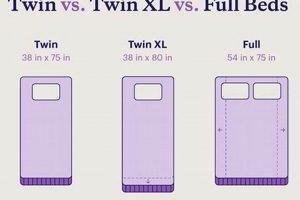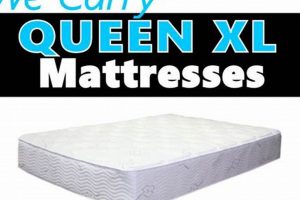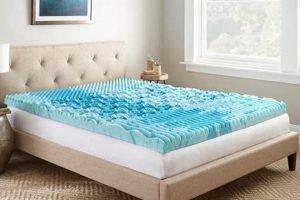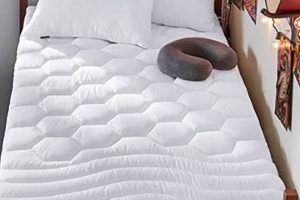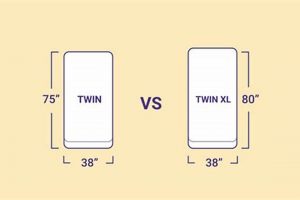An extra-long twin bed enhancement constructed of viscoelastic foam offers increased comfort and support. These products conform to the body, alleviating pressure points and promoting better spinal alignment on beds longer than standard twin sizes. These are designed to fit beds commonly found in college dormitories or for taller individuals needing additional length.
The significance of such an item lies in its capacity to improve sleep quality and overall well-being. Benefits include enhanced comfort, reduced tossing and turning, and a more restful sleep experience. Historically, these foam enhancements emerged as a solution to improve the often-uncomfortable sleeping arrangements found in institutional settings, offering a cost-effective upgrade without replacing the entire mattress.
Further investigation into specific density grades, thickness options, and certifications related to material composition will provide a more nuanced understanding of selecting the most appropriate bed enhancement. Consideration should also be given to factors such as heat dissipation properties and cleaning instructions to ensure optimal performance and longevity.
Selection and Maintenance Guidance
The following recommendations aim to facilitate informed purchasing and proper care procedures for prolonged utility.
Tip 1: Density Evaluation. Prioritize models with a density rating commensurate with individual weight and support requirements. Higher density typically equates to greater durability and support. As an example, individuals exceeding 200 pounds may benefit from a density of 4 pounds per cubic foot or higher.
Tip 2: Thickness Considerations. Evaluate thickness based on the existing mattress condition. A thicker model is often preferable for older or less supportive mattresses. Thickness can range from 2 to 4 inches, each offering varying degrees of added comfort.
Tip 3: Certification Verification. Verify CertiPUR-US certification to ensure the absence of harmful chemicals and low VOC emissions. This certification provides assurance of product safety and environmental responsibility.
Tip 4: Heat Dissipation Features. Investigate cooling technologies incorporated into the design, such as gel infusions or open-cell structures, to mitigate heat retention. Consider models specifically designed for hot sleepers.
Tip 5: Protective Encasement Implementation. Employ a waterproof and breathable encasement to safeguard against spills and allergens. This proactive measure enhances hygiene and extends the lifespan of the product.
Tip 6: Regular Rotation Protocol. Implement a routine rotation schedule, typically every 1-3 months, to promote even wear and prevent indentation. Rotate both lengthwise and flip if applicable, to maximize lifespan.
Tip 7: Adherence to Manufacturer’s Cleaning Instructions. Refer to and strictly adhere to the manufacturer’s cleaning guidelines to maintain material integrity and prevent damage. Avoid harsh chemicals that could degrade the foam.
Adhering to these recommendations ensures an optimized sleep experience and maximizes the value and lifespan of this product.
Consideration of these guidelines provides a solid foundation for an informed and beneficial consumer experience, prior to reviewing specific product comparisons.
1. Firmness Level
The firmness level of an extra-long twin viscoelastic foam bed enhancement significantly impacts sleep quality and physical well-being. As the primary determinant of surface conformity, firmness dictates how the product interacts with the sleeper’s body. A direct correlation exists between firmness selection and the alleviation of pressure points, skeletal alignment, and reduction of discomfort. For example, individuals experiencing back pain may benefit from a firmer surface, which provides greater spinal support and minimizes sagging, preventing further aggravation of existing conditions. Conversely, those with joint pain might find a softer surface more accommodating, as it allows for greater contouring and reduced pressure on sensitive areas.
The importance of selecting an appropriate firmness level extends beyond immediate comfort. Incorrect firmness can contribute to chronic pain, restless sleep, and ultimately, reduced overall health. The practical significance of understanding firmness variations lies in the ability to customize the sleep surface to meet individual needs. A bed enhancement that is too soft may lead to a feeling of being enveloped, potentially hindering movement and causing overheating. A product that is too firm may create pressure points, leading to discomfort and disrupted sleep. Therefore, a thorough evaluation of personal preferences, physical condition, and sleeping style is essential prior to making a purchase.
In summary, the firmness level is a critical component influencing the effectiveness of an extra-long twin viscoelastic foam bed enhancement. Its selection directly impacts comfort, support, and long-term health. Challenges arise in determining the ideal firmness, as individual needs vary significantly. By carefully considering personal requirements and understanding the implications of different firmness levels, consumers can make informed decisions that promote optimal sleep and well-being. This knowledge provides a foundation for informed choices when considering specific product features and comparisons.
2. Density Grade
Density grade, measured in pounds per cubic foot (PCF), is a critical determinant of an extra-long twin viscoelastic foam bed enhancement’s performance and longevity. Higher density generally correlates with increased durability, support, and resistance to compression over time. A denser product will withstand greater weight and pressure without significant deformation, maintaining its original shape and providing consistent support throughout its lifespan. Conversely, a lower density grade indicates a less robust structure, prone to quicker degradation and reduced support, potentially leading to premature sagging and a diminished sleep experience. For example, a bed enhancement used nightly by a college student will experience substantial wear; a higher density grade is essential to ensure it withstands regular use and maintains its supportive properties for an extended period.
The practical implications of density grade extend to heat dissipation and motion isolation. Denser materials often exhibit reduced airflow, potentially leading to increased heat retention. Manufacturers address this through various cooling technologies, such as gel infusions or open-cell structures, to counteract this effect. Motion isolation, the ability to minimize the transfer of movement across the surface, is also influenced by density. Higher density foams typically absorb motion more effectively, reducing disturbances for co-sleepers. Consider a scenario where a student shares a dorm room; a higher density product will minimize disruptions caused by one student’s movements during the night, promoting better sleep for both occupants. This understanding is vital when selecting a product that balances support, durability, and thermal comfort.
In conclusion, density grade is a key performance indicator that significantly affects the lifespan, support, and overall sleep experience offered by an extra-long twin viscoelastic foam bed enhancement. Challenges may arise in discerning accurate density information from marketing claims, emphasizing the need for verified specifications and certifications. By understanding the relationship between density grade and performance characteristics, consumers can make informed decisions that align with their individual needs and ensure long-term satisfaction with their purchase. This provides a solid basis for evaluating and comparing different product offerings.
3. Thickness Variation
Thickness variation in extra-long twin viscoelastic foam bed enhancements directly influences the level of comfort and support provided. The thickness of the foam layer dictates the degree of contouring and pressure relief experienced by the user. A thicker enhancement generally offers more substantial cushioning and is better suited for individuals seeking significant pressure alleviation or those using older, less supportive mattresses. Conversely, a thinner enhancement may provide a subtle enhancement to comfort without drastically altering the existing mattress feel. For instance, an individual with a relatively new mattress may opt for a thinner (e.g., 2-inch) version to add a slight layer of conforming comfort, while someone with an older, sagging mattress may require a thicker (e.g., 4-inch) enhancement to compensate for the lack of support.
The practical significance of understanding thickness variation extends to bed height and compatibility with bedding. A thicker enhancement will increase the overall height of the bed, potentially requiring deeper pocket sheets to ensure a proper fit. Furthermore, it’s essential to consider the potential impact on access for individuals with mobility limitations; a significantly thicker enhancement may make it more challenging to get in and out of bed. The choice of thickness should also be aligned with the user’s sleeping position. Side sleepers typically benefit from thicker enhancements to cushion the shoulders and hips, while back and stomach sleepers may prefer thinner options for better spinal alignment. The understanding of thickness and its impact on support and bedding requirements facilitates a more tailored approach to selection.
In summary, thickness variation is a critical specification determining the magnitude of comfort and support provided by an extra-long twin viscoelastic foam bed enhancement. Navigating the available thickness options requires careful consideration of individual needs, mattress condition, and practical implications related to bed height and bedding compatibility. The challenge lies in balancing the desire for enhanced comfort with the practical considerations of bed accessibility and bedding requirements. A thorough assessment of these factors enables informed decision-making and maximizes the potential for a satisfying and beneficial sleep experience.
4. Material Composition
The composition of materials within an extra-long twin viscoelastic foam bed enhancement directly dictates its performance characteristics, including support, durability, breathability, and hypoallergenic properties. Understanding these compositional elements is crucial for informed selection and ensuring the product meets individual needs and preferences.
- Viscoelastic Foam Density and Type
The primary component, viscoelastic foam, is characterized by its density and formulation. Higher density foams provide enhanced support and durability, while variations in the foam’s chemical makeup affect its responsiveness and conforming ability. Traditional viscoelastic foam is known for its slow response time, while newer formulations incorporate gel or other additives to improve airflow and reduce heat retention. For example, a high-density viscoelastic foam infused with gel particles offers both superior support and enhanced thermal regulation, ideal for warmer sleepers.
- Support Layer Materials
Many extra-long twin viscoelastic foam bed enhancements incorporate a base support layer to provide additional stability and prevent sagging. This layer may consist of high-density polyurethane foam, convoluted foam, or even a layer of pocketed coils. The support layer’s material significantly impacts the overall feel and longevity of the product. A high-density polyurethane foam base provides firm support, while a convoluted foam layer enhances airflow and reduces pressure points. The presence and quality of the support layer contribute significantly to the overall performance and lifespan of the bed enhancement.
- Cover Fabric and Construction
The outer cover material plays a critical role in breathability, moisture management, and protection of the foam core. Common cover materials include cotton, polyester, rayon from bamboo, and blends thereof. The fabric’s weave and construction influence its ability to wick away moisture and promote airflow. For instance, a breathable knit fabric with moisture-wicking properties helps to regulate temperature and prevent the buildup of moisture, creating a more comfortable sleep environment. The cover also acts as a barrier against dust mites and allergens, contributing to the overall hygiene of the bed enhancement.
- Fire Retardant Treatments
By law, mattress products including bed enhancements must meet flammability standards. Chemical or non-chemical fire retardants are often integrated into the foam or cover materials. Boric acid is a commonly used, non-chemical retardant. Consumers may wish to verify the type of flame retardant used and potential health implications when selecting the product. Third-party certifications, such as CertiPUR-US, can assure the absence of harmful chemicals and compliance with safety regulations. Understanding the fire retardant treatment used allows for informed purchasing decisions that align with individual health and environmental concerns.
The interplay between these compositional elements determines the overall comfort, support, and longevity of an extra-long twin viscoelastic foam bed enhancement. Variations in foam density, support layer materials, cover fabric, and fire retardant treatments result in a wide range of performance characteristics and price points. Informed consumers consider these factors to choose a product that aligns with their specific needs, preferences, and budget.
5. Cooling Technology
Temperature regulation is a significant consideration in the design and selection of extra-long twin viscoelastic foam bed enhancements. The inherent properties of viscoelastic foam, while providing pressure relief and conforming support, often lead to heat retention. Cooling technologies are integrated to mitigate this issue, enhancing sleep comfort and preventing overheating.
- Gel Infusion
Gel infusion involves the introduction of gel particles into the viscoelastic foam matrix during manufacturing. These particles possess a higher thermal conductivity than the surrounding foam, facilitating heat transfer away from the body. This technology is commonly employed in extra-long twin bed enhancements to address the heat retention associated with dense foam structures. An example includes the incorporation of phase-change materials within the gel, further enhancing its ability to absorb and release heat. The efficacy of gel infusion depends on the concentration and type of gel used, with higher concentrations typically yielding better cooling performance.
- Open-Cell Structure
Open-cell foam features interconnected air channels, allowing for greater airflow and ventilation compared to traditional closed-cell viscoelastic foam. This enhanced airflow promotes heat dissipation and reduces moisture accumulation, contributing to a cooler sleep environment. Extra-long twin bed enhancements utilizing open-cell structures offer improved breathability, making them suitable for individuals prone to overheating. The degree of openness in the cell structure varies among products, with more porous foams exhibiting superior cooling capabilities. This structural modification addresses the common concern of heat buildup associated with viscoelastic foam.
- Ventilated Designs
Ventilation channels or perforations are strategically incorporated into the foam structure to enhance airflow and promote heat dissipation. These channels create pathways for heat to escape, preventing localized temperature increases. Some extra-long twin bed enhancements feature surface indentations or convoluted patterns to increase surface area and improve air circulation. The effectiveness of ventilated designs depends on the size, density, and placement of the channels. These designs provide a passive cooling mechanism, complementing other cooling technologies.
- Phase Change Materials (PCM)
PCMs are substances that absorb and release thermal energy during the process of melting and solidifying. When integrated into the cover fabric or foam of an extra-long twin viscoelastic foam bed enhancement, PCMs regulate temperature by absorbing heat when the sleeper is warm and releasing heat when the sleeper is cool. The use of PCM contributes to maintaining a stable and comfortable sleep temperature throughout the night. This proactive thermoregulation technology provides more consistent comfort than simpler ventilation techniques.
The integration of cooling technologies into extra-long twin viscoelastic foam bed enhancements represents a targeted effort to address the inherent thermal limitations of viscoelastic foam. These technologies vary in their mechanisms and effectiveness, and selection should be based on individual preferences, sleeping habits, and environmental conditions. Understanding the specific cooling technologies employed in a given product enables informed decision-making and optimizes sleep comfort. Consider comparison with products which lack any of these technologies.
6. Size Accuracy
The dimensional precision of an extra-long twin viscoelastic foam bed enhancement is paramount to its functionality and intended benefits. Deviations from specified dimensions compromise fit, comfort, and support, thus negating the product’s value. Size inaccuracy introduces a range of challenges for the consumer.
- Mattress Compatibility
Dimensional fidelity ensures proper alignment with the extra-long twin mattress, typically measuring 39 inches wide and 80 inches long. An undersized enhancement leaves portions of the mattress exposed, reducing the consistent support surface. Conversely, an oversized enhancement bunches or overlaps, creating uneven pressure points and compromising comfort. For example, a bed enhancement labeled as extra-long twin but measuring 78 inches in length will leave two inches of the mattress uncovered, particularly problematic at the foot of the bed.
- Bedding Fit
Standard extra-long twin bedding, including fitted sheets, is designed to accommodate mattresses of specific dimensions. An inaccurately sized bed enhancement alters the overall mattress profile, potentially rendering existing bedding incompatible. Fitted sheets may not adequately cover the enhanced mattress, resulting in slippage or tearing. In extreme cases, new, custom-sized bedding becomes necessary, incurring additional expense and inconvenience. A topper that is too thick can cause fitted sheets to tear and not fit properly.
- Support Uniformity
Dimensional inconsistencies within the bed enhancement itself create uneven support zones. Variations in thickness or width lead to localized areas of increased or decreased firmness, disrupting spinal alignment and potentially exacerbating pressure points. Such inconsistencies negate the intended benefits of viscoelastic foam, diminishing its ability to contour to the body and provide uniform support. When the edge of the topper is not cut straight and varies in thickness, the sleeper might roll off the bed.
- Long-Term Durability
Size inaccuracies often indicate manufacturing defects or material inconsistencies, which can negatively impact the long-term durability of the bed enhancement. Deviations from specified dimensions suggest a lack of quality control and may indicate the use of inferior materials. Such products are more susceptible to premature wear, compression, and deformation, reducing their lifespan and compromising their ability to provide consistent support over time. Over time the topper might shrink or expand unevenly with use.
Therefore, verifying dimensional accuracy prior to purchase is critical. Measures can include confirming stated dimensions with the vendor, reviewing product specifications, and scrutinizing customer reviews for reported sizing issues. Discrepancies in size serve as warning signs, indicating potential compromises in quality and performance. A accurately sized topper is essential for the correct performance of your bed.
7. Certifications
Certifications serve as independent verification of an extra-long twin viscoelastic foam bed enhancement’s adherence to specific safety, performance, or environmental standards. These certifications provide consumers with objective assurance regarding the product’s quality and characteristics, mitigating potential risks associated with unregulated manufacturing practices.
- CertiPUR-US Certification
CertiPUR-US certification indicates that the viscoelastic foam utilized in the extra-long twin bed enhancement has been tested and verified to be free from certain harmful chemicals, including ozone depleters, PBDE flame retardants, mercury, lead, and formaldehyde. This certification also ensures low VOC (Volatile Organic Compound) emissions for indoor air quality. The presence of the CertiPUR-US seal on a product assures consumers that the foam meets stringent safety standards and minimizes potential health risks associated with chemical exposure.
- OEKO-TEX Standard 100 Certification
OEKO-TEX Standard 100 certification assesses the textile components of the bed enhancement, including the cover fabric, for harmful substances. This certification verifies that the textile materials are free from allergenic dyes, pesticides, and heavy metals. An extra-long twin bed enhancement bearing the OEKO-TEX Standard 100 label provides assurance that the fabric components are safe for direct skin contact and minimize the risk of allergic reactions or skin irritation.
- GREENGUARD Certification
GREENGUARD Certification focuses on the chemical emissions of products, ensuring that they meet stringent standards for low VOC emissions. This certification is particularly relevant for extra-long twin bed enhancements, as they are used in close proximity to the sleeper. GREENGUARD certified products contribute to healthier indoor air quality, reducing the potential for respiratory irritation and other health concerns. This certification assures consumers that the bed enhancement has been tested and verified to minimize chemical off-gassing.
- Other Relevant Certifications
Depending on the specific features of the extra-long twin bed enhancement, other certifications may be relevant. For example, a certification related to organic materials would indicate the use of organically grown cotton or other natural fibers in the cover fabric. Certifications related to fire safety standards, such as compliance with 16 CFR Part 1633, ensure that the product meets flammability requirements. Examining a product label can reveal the product origin.
The presence of relevant certifications on an extra-long twin viscoelastic foam bed enhancement provides consumers with valuable information regarding the product’s safety, quality, and environmental impact. While certifications do not guarantee perfection, they offer an objective and independent assessment that can aid in informed decision-making, minimizing the risks associated with selecting a product that directly impacts sleep quality and overall well-being. It is important to check the official certification website to ensure the certification is valid and has not been revoked.
Frequently Asked Questions
The following questions and answers address common inquiries and concerns regarding the selection, use, and maintenance of extra-long twin viscoelastic foam bed enhancements.
Question 1: What is the typical lifespan of an extra-long twin viscoelastic foam bed enhancement?
The lifespan varies based on factors such as foam density, usage frequency, and maintenance practices. Higher density enhancements generally exhibit greater durability, with expected lifespans ranging from 3 to 7 years. Regular rotation and the use of a protective cover can extend the product’s longevity. Products utilized more than occasionally should maintain the form for at least 3 years.
Question 2: How does firmness level affect suitability for different sleeping positions?
Firmness level is a critical consideration for spinal alignment and pressure relief. Side sleepers typically benefit from medium to soft firmness levels to cushion the shoulders and hips. Back sleepers generally prefer medium-firm options for optimal spinal support. Stomach sleepers may find firmer enhancements more suitable to prevent excessive sinking and maintain proper alignment.
Question 3: Can an extra-long twin viscoelastic foam bed enhancement alleviate back pain?
While not a guaranteed solution, these enhancements can contribute to back pain relief by conforming to the body’s contours and reducing pressure points. The effectiveness depends on the underlying cause of the back pain, the firmness level of the enhancement, and individual preferences. A consultation with a healthcare professional is recommended for persistent back pain.
Question 4: What is the best method for cleaning an extra-long twin viscoelastic foam bed enhancement?
Spot cleaning with a mild detergent and water is generally recommended. Avoid immersing the entire enhancement in water or using harsh chemicals, as this can damage the foam. Allow the product to air dry thoroughly before replacing bedding. Using a protective cover further minimizes the need for frequent cleaning. Always consult the manufacturers instructions first.
Question 5: How does density grade affect heat retention in viscoelastic foam?
Higher density viscoelastic foam tends to retain more heat due to reduced airflow. Enhancements incorporating cooling technologies, such as gel infusions or open-cell structures, mitigate this effect. Consumers sensitive to temperature should prioritize products with these features or consider alternative materials.
Question 6: What certifications should be considered when purchasing an extra-long twin viscoelastic foam bed enhancement?
CertiPUR-US certification assures the absence of harmful chemicals and low VOC emissions. OEKO-TEX Standard 100 certification verifies the safety of textile components. GREENGUARD certification indicates low chemical emissions for improved indoor air quality. These certifications provide objective verification of product safety and environmental responsibility.
In summary, careful consideration of firmness level, density grade, cleaning methods, and relevant certifications will aid in selecting an extra-long twin viscoelastic foam bed enhancement that meets individual needs and promotes optimal sleep quality. Failure to research these properties may result in a product that does not meet a sleeper’s expectations.
The following section will explore specific brands and models of extra-long twin viscoelastic foam bed enhancements, providing a comparative analysis of their features and benefits.
Conclusion
The preceding analysis provides a comprehensive overview of the extra-long twin viscoelastic foam bed enhancement category. Key elements such as firmness, density, thickness, material composition, cooling technology, size accuracy, and certifications directly influence product performance and suitability for individual needs. The information presented equips consumers to make informed decisions, optimizing their sleep environment.
Ultimately, the selection of a suitable extra-long twin viscoelastic foam bed enhancement constitutes a significant investment in sleep quality and overall well-being. Continued advancements in materials and manufacturing techniques promise further enhancements to these products, potentially yielding even greater comfort and support. The long-term benefits derived from a well-chosen enhancement justify a diligent approach to the purchasing process.


